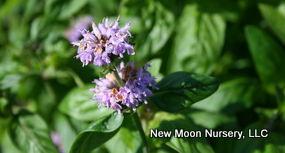New Moon Nurseries
Blephilia ciliata
Downy wood mint
Native to North America
FIRST IMPRESSIONS: Blephilia ciliata is an upright clump forming perennial. Stems are stout and square and are clad in oblong gray-green leaves. In early summer dense rounded lavender to pink globular flower clusters encircle the stems. The flowers are frequented by native bees and other pollinators. This Mint Family member is less aggressive and less aromatic than many other mints. In bloom it closely resembles its Monarda spp. cousins. Plants flourish in sun or part sun in average to dry soils.
HABITAT & HARDINESS: Blephilia ciliata ranges through most of Eastern North American and through parts of the Central United States. Plants occur from Canada south to Georgia and west to Oklahoma.
This species is indigenous to dry open woods, prairies, savannas, limestone bluffs, glades, barrens, clearings, fields, steep slopes, disturbed sites and roadsides. Plants often occur in thin soils over limestone.
Hardiness rating extends from USDA Zones 4-8.
PLANT DESCRIPTION: Young Blephilia ciliata plants are sturdy and upright with angular unbranched stems. Plants expand slowly to form dense clumps with many vertical stems that are anchored by a substantial tap root.
Foliage is toothed and lance shaped or oblong. The leaves are opposite or arranged in pairs along the stem. Leaves and stems are pubescent and faintly aromatic when crushed.
In late spring and summer, dense whorls of clustered flowers encompass the stems for about a month. The tiny individual flowers are two lipped and pink, lavender or white with purple spots.
Scads of native pollinators visit the flowers. After the foraging, attractive spherical seed heads form. The seed clusters remain on the plant all winter along with cheerful green basal leaves.
Plants attain a 1-2’ height with 1-2’ spread.
CULTURAL & MAINTENANCE NEEDS: Despite the common name, Blephilia ciliata occurs more often in open areas than in woodlands.
Plants grow best in full sun or part sun with average or dry soils.
Plants tolerate drought and are somewhat unpalatable to deer, rabbits and livestock.
In moist or shaded sites foliage is often afflicted with powdery mildew. Leaves may be nibbled by insects and become disheveled by late summer. If this is an issue, stems can be cut back to regenerate after new basal foliage emerges in summer.
Excess shade and competition from neighboring plants can cause plants to weaken and decline.
LANDSCAPE USES: This is a good choice for a Pollinator Garden, Prairie or Meadow. Plants are also used as Butterfly Nectar Plants or as part of a Groundcover or Mass Planting. Blephilia ciliata has Showy Blooms and can be utilized in Cottage Gardens, Deer Resistant Plantings, Rock Gardens, Water-wise Landscapes, Low Maintenance Plantings, Perennial Borders, Restoration Projects and Wildlife Gardens.
COMPANION & UNDERSTUDY PLANTS: Try pairing with Aster laevis, Phlox pilosa, Coreopsis tripteris, Solidago nemoralis, Bouteloua curtipendula, Sorghastrum nutans or Schizachyrium scoparium.
Monarda punctata has similar height, flowers and cultural needs and can be substituted if needed.
TRIVIA: Sometimes called Downy Pagoda Plant due to the “pagoda-like” flower arrangement with one flower cluster on top of the other.
Linnaeus described Blephilia ciliata as Monarda ciliata.
Height:
1-2 ftSpread:
1-2 ftSpacing:
2-3 ftUSDA Hardiness Zone:
4-8Bloom Color:
PinkBlephilia ciliata Characteristics
Attracts Wildlife
- Butterflies
- Pollinators
Attributes
- Naturalizing
- Interesting Foliage
- Favorite
- Rain Garden
- Drought Tolerant
- Dried Flower
Exposure
- Full Sun to Partial Shade
Flowering Months
- August
- July
- June
Foliage Color
- Green
Growth Rate
- Medium
Season of Interest (Foliage)
- Summer
- Spring
Soil Moisture Preference
- Moist to Dry
Interesting Notes:
For more information on this plant, visit the USDA PLANTS Database: http://plants.usda.gov/java/profile?symbol=BLCI
